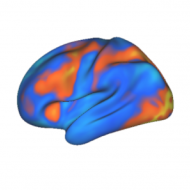Topic 2: Conflict and Cooperation
Generally, cognitive neuroscience aims to explain how mental processes such as believing, knowing, and inferring arise in the brain and affect behavior. Two behaviors that have important effects on the survival of humans are cooperation and conflict.
According to the NSF committee convened last year, conflict and cooperation is an important focus area for future cognitive neuroscience work. Although research in this area has typically been the domain of psychologists, it seems that the time is ripe to apply findings from neuroscience to ground psychological theories in the underlying biology.
Neuroscience has produced a large amount of information about the brain regions that are relevant to social interactions. For example, the amygdala has been shown to be involved in strong emotional responses. The “mirror” neuron system in the frontal lobe allows us to put ourselves in someone else’s shoes by allowing us to understand their actions as though they were our own. Finally, the superior temporal gyrus and orbitofrontal cortex, normally involved in language and reward respectively, have also been shown to be involved in social behaviors.
Experiments?
The committee has left it up to us to come up with a way to study these phenomena! How can we study conflict and cooperation from cognitive neuroscience perspective?
At least two general approaches come to mind. The first is fMRI studies in which social interactions are simulated (or carried out remotely) over a computer link to the experiment participant. A range of studies of this sort have recently begun to appear investigating trust and decision-making in social contexts.
The second general approach that comes to mind is that of using neurocomputational simulations of simple acting organisms with common or differing goals. Over the past few years, researchers have been carrying out studies with multiple interacting “agents” that “learn” through the method of Reinforcement Learning.
Reinforcement Learning is an artificial intelligence algorithm which allows “agents” to develop behaviors through trial-and-error in an attempt to meet some goal which provides reward in the form of positive numbers. Each agent is defined as a small program with state (e.g., location, sensory input) and a memory or “value function” which can keep track of how much numerical reward it expects to obtain by choosing a possible action.
Although normally thought to be of interest only to computer scientists, Reinforcement Learning has recently attracted the attention of cognitive neuroscientists because of emerging evidence that something like it might be used in the brain.
By providing these agents with a goal that can only be achieved through some measure of coorperation or under some pressure, issues of conflict and coorperation can by studied in a perfectly controlled computer simulation environment.
-PL
